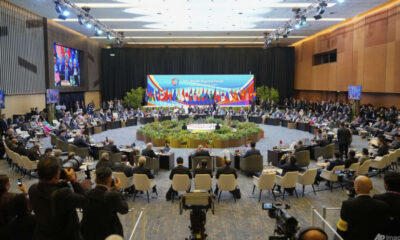Business
Asia Shares Decline as Euro Struggles Amid Tariff Concerns

Asian shares experienced a decline on Tuesday, as investors grappled with the implications of existing tariffs following a recent U.S.-EU trade agreement. The euro remained flat, recovering from a significant drop, reflecting the market’s unease about the potential economic fallout from increased trade costs.
The initial optimism surrounding a 15 percent tariff on European imports quickly dissipated when compared to the previous rates of 1 percent to 2 percent before Donald Trump assumed the presidency. Leaders in France and Germany expressed concern over these developments, predicting a detrimental impact on economic growth. As a result, stock and bond yields across Europe fell, while the euro faced downward pressure.
Market Reactions and Economic Projections
In a recent analysis by economists at JPMorgan, the bank highlighted that while a worst-case scenario was avoided, the increase in EU tariffs represents a substantial tax hike on exports. They commented, “This is a very big shock that unwinds a century of U.S. leadership in global free trade.” They estimated the risk of a U.S. recession at 40 percent due to these tariff changes.
The energy market also reacted to geopolitical tensions, particularly following President Trump’s ultimatum to Russia regarding its involvement in the war in Ukraine. This prompted a spike in oil prices, contributing to the overall sense of caution in the markets. The MSCI Asia-Pacific index, excluding Japan, fell by 0.8 percent, while Japan’s Nikkei index dropped by 0.9 percent. Chinese blue-chip stocks remained largely unchanged.
In Europe, markets showed signs of stabilization after a sell-off on Monday, with futures for the EUROSTOXX 50, FTSE, and DAX all rising approximately 0.2 percent. The euro steadied at $1.1587, recovering slightly after a 1.3 percent decline, which marked its largest drop since mid-May.
U.S. Market Outlook and Interest Rate Decisions
The dollar index saw an increase, reaching 98.675, as a rush out of short dollar positions lifted its value by 1 percent overnight. The yen also experienced slight fluctuations, standing at 148.27 against the dollar. Wall Street remained resilient, buoyed by expectations for positive earnings reports from major companies such as Apple, Meta Platforms, Microsoft, and Amazon. Futures for the S&P 500 and Nasdaq increased by 0.1 percent and 0.2 percent respectively.
Yields on 10-year U.S. Treasuries held steady at 4.408 percent, having risen slightly on Monday as markets prepared for a likely steady interest rate decision from the Federal Reserve during its upcoming meeting. Current futures indicate a 97 percent probability that rates will remain between 4.25 percent and 4.5 percent. Analysts anticipate at least one dissenting vote in favor of a rate cut, which could shift expectations for September.
In Canada, the central bank is also scheduled to meet this Wednesday, with expectations that it will maintain rates at 2.75 percent while monitoring the outcomes of ongoing trade discussions with the U.S.
Commodity markets faced pressure as prices for copper and iron ore declined. Gold remained stable at $3,315 per ounce, while Brent crude slipped slightly to $69.90 per barrel after a 2.3 percent increase on Monday. U.S. crude prices held steady at $66.60.
-

 Business5 months ago
Business5 months agoKenvue Dismisses CEO Thibaut Mongon as Strategic Review Advances
-

 Lifestyle4 months ago
Lifestyle4 months agoHumanism Camp Engages 250 Youths in Summer Fest 2025
-

 Sports4 months ago
Sports4 months agoDe Minaur Triumphs at Washington Open After Thrilling Comeback
-

 Sports5 months ago
Sports5 months agoTupou and Daugunu Join First Nations Squad for Lions Clash
-

 Top Stories5 months ago
Top Stories5 months agoColombian Senator Miguel Uribe Shows Signs of Recovery After Attack
-

 World5 months ago
World5 months agoASEAN Gears Up for Historic Joint Meeting of Foreign and Economic Ministers
-

 Health4 months ago
Health4 months agoNew Study Challenges Assumptions About Aging and Inflammation
-

 Business5 months ago
Business5 months agoOil Prices Surge Following New EU Sanctions on Russia
-

 Entertainment4 months ago
Entertainment4 months agoDetaşe-Sabah Violin Ensemble Captivates at Gabala Music Festival
-

 Entertainment4 months ago
Entertainment4 months agoBaku Metro Extends Hours for Justin Timberlake Concert
-

 Top Stories5 months ago
Top Stories5 months agoRethinking Singapore’s F&B Regulations Amid Business Closures
-

 Business5 months ago
Business5 months agoU.S. House Approves Stablecoin Bill, Sends to Trump for Signature









